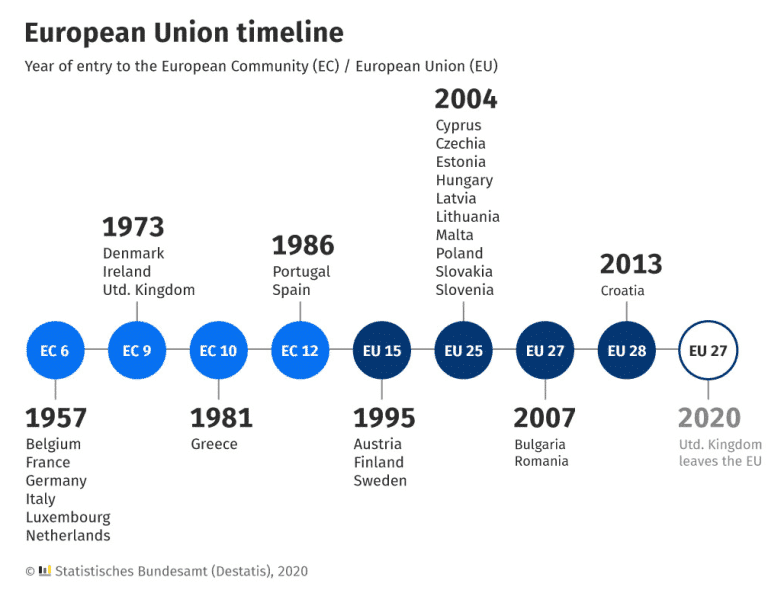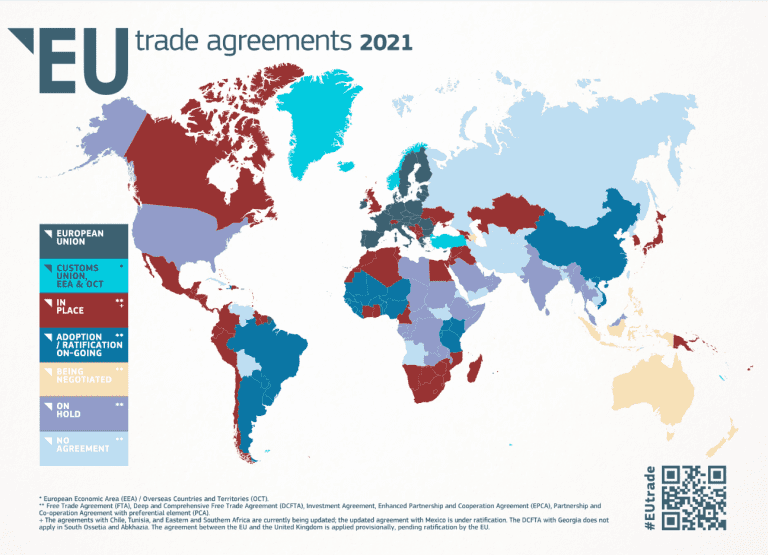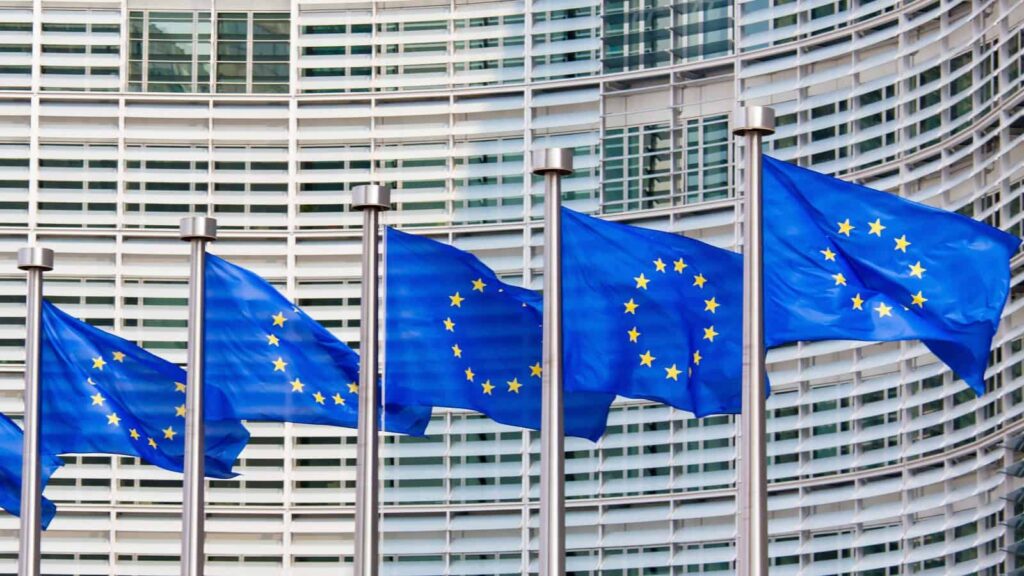Setting the stage for the EU free trade zone
As we continue our series on significant trade agreements, this week we will be discussing the European Union (EU). The EU is a crucial player in global trade as it is the world’s largest single market area and one of the most outward-focused economies
Although the EU is not exclusively an FTA, it was founded on the principle of free trade among its members and has a longstanding dedication to promoting global trade liberalization.
What is the EU? Defining the European Union and its role in global trade
The European Union (EU) is an economic and political union between 27 European countries. Originally created in 1958 between six countries, the agreement has expanded over the decades and now includes 27 countries across the European continent.

Member States of the European Union in 2022
The EU’s free trade zone is based on a multilateral agreement that centers on the creation of an internal single market. This single market was established by the EU customs union and is based on a uniform legal framework and legislation that applies to all member states, enabling them to act collectively as a single entity. The EU enables goods, services, money and people to move freely within the internal market.
Milestones and events that shaped the EU’s trade policy
The roots of the European Union today can be traced back to treaties signed in the aftermath of the Second World War. Following the devastation of the war, countries focused on fostering economic cooperation, with the goal of creating economic interdependence between countries through trade. The belief was that this interdependence would result in countries avoiding conflict with each other.
In 1957, the European Economic Community, which later evolved into the EU, was formed with the objective of enhancing economic cooperation among six European nations, namely Belgium, France, Germany, Italy, Luxembourg, and the Netherlands.
Since then, the EU has evolved, with an additional 22 countries joining, and the United Kingdom exiting the union in 2020.

The EU has played a crucial role in delivering more than five decades of peace, stability, and prosperity to its members. What started as an economic union among six countries has evolved into an organization of 27 member countries, encompassing policy areas such as climate, environment, health, external relations and security, justice, and migration.
The EU’s approach to trade
The EU is committed to moving towards open and fair world-wide trade. While free trade among its members was a founding principle of the union, the EU today is one of the most outward-oriented economies in the world and is also focused on fostering trade between member states and external bodies.
The main economic engine of the EU is its internal single market. This is an economic area without internal borders that was created from several national markets.
The EU operates their internal single market on the basis of the ‘four freedoms’:
Free movement of goods
- The free movement of goods allows goods to travel freely within the internal market. A common external tariff is applied on all goods entering the market and controls are only in place at the external borders of the single market. This means that once the goods have been admitted to the market, they will not be subject to further tariffs as they travel internally.
Free movement of persons
- The free movement of persons allows EU citizens to both pursue employment and reside in all EU member states. Passport checks have been removed from all internal borders, and there is greater mobility for EU citizens within the internal market.
Freedom to provide services
- The freedom to provide services allows EU citizens to carry out cross-border activities as self-employed persons within the internal market. This liberty enables a more extensive selection of goods and services to be provided throughout the internal market.
Free movement of capital
- Unrestricted movement of capital between member states is permitted under the free movement of capital. This freedom ensures that restrictions on all internal payment transactions and transfers are lifted in order to create the conditions for a monetary union.
Alongside provisions for trade within the internal market, the EU also promotes external trade as well.
The EU’s trade and investment policy governs its trade and investment relationships with non-EU countries, and EU institutions are responsible for establishing and overseeing all trade regulations and legislation.
Furthermore, EU institutions are also responsible for negotiating and signing all international trade agreements on behalf of member countries.
The EU external trade responsibilities include:
- trade in goods and services;
- the commercial aspects of intellectual property, such as patents;
- public procurement, and;
- foreign direct investment.
EU Free Trade Agreements
The EU actively engages with countries in negotiating trade agreements. As the largest trading bloc globally, the EU is the primary trading partner for more than 80 countries and is among the most open economies worldwide.
The EU is responsible for the trade policies of its member countries and negotiates agreements on their behalf. Each agreement negotiated by the EU is unique and can include provisions such as reductions in tariffs, rules regarding matters like intellectual property or even clauses regarding human rights. Furthermore, the EU also works with the World Trade Organization (WTO) helping to set rules for global trade and reducing trade barriers between WTO members.
The EU seeks to negotiate trade agreements that will grant mutually beneficial access to the markets of the parties involved. The average applied tariff for goods imported into the EU is very low, with more than 70% of these imports entering at zero or reduced tariffs. This is all a result of their commitment to free trade and their openness to negotiating trade agreements.

Currently, the EU has 50 trade agreements in force, with 39 being fully ratified and 11 being provisionally applied. Furthermore, they also have 6 trade agreements finalized, where negotiations have been concluded but the agreements have not yet been signed and are currently in negotiations for 9 new agreements while 9 trade agreement negotiations are on hold.
The Impact of the EU Trade Agreement: Positive Effects, Criticisms, and Future Prospects
Through acting collectively as a unified entity, EU member countries have gained more negotiating power in trade agreements and have achieved a substantial number of advantageous agreements.
Today, EU member countries account for 16% of world imports and exports, importing and exporting hundreds of millions of euros worth of goods daily.
Through strengthening economic governance, designing systems to safeguard financial stability, improving public finances and promoting reforms to encourage investment for its member states, the EU has not only greatly benefited the European economy, but has also benefited European citizens through the increased standard of living that member states have experienced.
The EU has been an active force in expanding international trade. Through their many trade agreements, the EU has become an influential player in removing barriers to trade and promoting high standards of labor and environment protection around the world.
However, the EU has also faced struggles over the past few years, most notably with the United Kingdom’s exit from the union in 2020, commonly referred to as ‘Brexit’. The decision to withdraw from the union was affected by factors such as sovereignty, immigration, the economy, anti-establishment politics, and various other factors. The situation demonstrated some of the potential challenges that EU member countries may encounter.
Although Brexit had a significant impact globally and within the EU, the EU still remains the largest trading bloc globally, and its member countries continue to benefit significantly from the internal single market and various trade agreements across the world.
In conclusion, despite the challenges and uncertainties that the EU has faced over the years, it remains a formidable and critical player in the global trading arena. Looking forward, the EU is well-positioned to continue playing a leading role in the global economy and tackle emerging challenges, such as climate change, digitalization, and social inclusion, with the same level of commitment and determination that has defined its success over the years. Overall, there are ample reasons to be optimistic about the future of the EU and its ability to shape the global trading landscape in the years ahead.
More from ResearchFDI:




